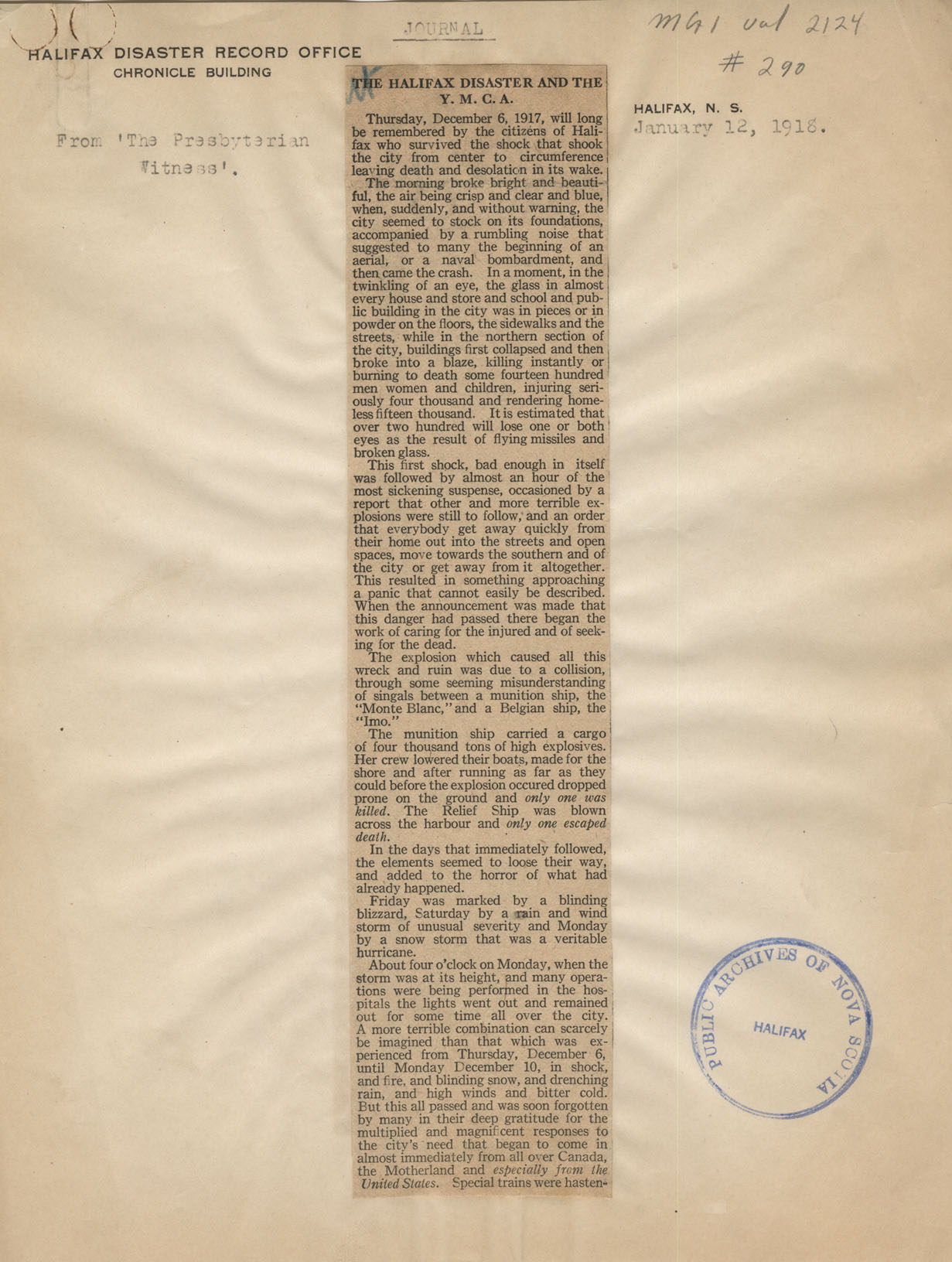Nova Scotia Archives
Archibald MacMechan
Halifax Disaster Record Office Materials
The Presbyterian Witness, "The Halifax Disaster and the Y.M.C.A."
12 January 1918. — 3 pages : 30 x 40 cm.
note: transcription publicly contributed - please contact us with comments, errors or omisions
Halifax Disaster Record Office
Chronicle Building
Journal
From the "Presbyterian Witness"
MG 1 Vol 2124
number 290
Halifax, N.S.
Janurary 12, 1918
THE HALIFAX DISASTER AND THE Y.M.C.A.
Thursday, December 6, 1917, will long be remembered by the citizens of Halifax who survived the shock that shook the city from center to circumference leaving death and desolation in its wake.
The morning broke bright and beautiful, the air being crisp and clear and blue, when, suddenly, and without warning, the city seemed to stock on its foundations, accompanied by a rumbling noise that suggested to many the beginning of an aerial, or a naval bombardment, and then came the crash. In a moment, in the twinkling of an eye, the glass in almost every house and store and school and public building in the city was in pieces or in powder on the floors, the sidewalks and the streets, while in the northern section of the city, buildings first collapsed and then broke into a blaze, killing instantly or burning to death some fourteen hundred men,, women and children, injuring seriously four thousand and rendering homeless fifteen thousand. It is estmated that over two hundred will lose one or both eyes as the result of flying missiles and broken glass.
This first shock, bad enough in itself was followed by almonst an hour of the most sickening suspense, occasioned by a report that other and more terrible explosions were still to follow, and an order that everygody get away quickly from their home out into the streets and open spaces, move towards the southern and of the city or get away from it altogether. This resulted in something approaching a panic that cannot easily be described. When the announcement was made that this danger had passed there began the work of caring for the injured and of seeking for the dead.
The explosion which caused all this wreck and ruin was due to a collision, through some seeming misunderstanding of singals between a munition ship, the "Monte Blanc," and a Belgian ship the "Imo."
The munition ship carried a cargo of four thousand tons of high explosives. Her crew lowered their boats, made for the shore and after running as far as they could before the explosion occured dropped prone on the ground and only one was killed. The Relief Ship was blown across the harbour and only one escaped death.
In the days that immediately followed the elements seemed to loose their way, and added to the horror of what had already happened.
Friday was marked by a blinding blizzard, Saturnday by a rain and wind storm of unusual severity and Monday by a snow storm that was a veritable hurricane.
About four o'clock on Monday, when the storm was at its height, and many operations were being performed in the hospitals the lights went out and remained out for some time all over the city. A more terrible combination can scarcely be imagined than that which was experienced from Thursday December 6, until Monday December 10, in shock, and fire, and blinding snow, and drenching rain, and high winds and bitter cold. But this all passed and was soon forgotten by many in their deep gratitude for the multiplied and magnificent responses to the city's need that began to come in almost immediately from all over Canada, the Motherland and especially from the United States. Special trains were hasten-
Public Archives of Nova Scotia
Reference: Archibald MacMechan Nova Scotia Archives MG 1 volume 2124 number 290

